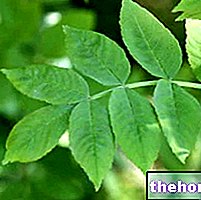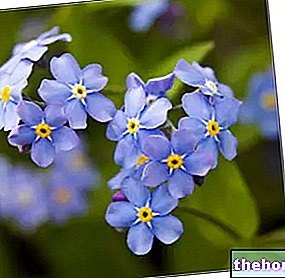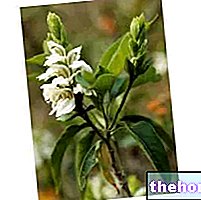Clay in herbal medicine
From a phytotherapeutic point of view, clay is used to treat disorders that afflict the gastro-intestinal system, such as abdominal swelling and tension, pain, constipation or diarrhea; more generally, clay is particularly suitable for irritable bowel syndrome.

It is good to remember that, often times, gastro-intestinal pains are closely linked to psychological stress; consequently, the intake of clay should also be accompanied by other plants with calming activities which, by relaxing the walls of the stomach and intestines, help to reduce swelling and abdominal cramps.
Following checks conducted by EFSA (the European Food Safety Authority) on the possible risks to human health deriving from the presence of aluminum in food, the Ministry of Health has recently changed the conditions of use of food additives containing aluminum.
In light of the restrictions adopted for the use of clays as additives, starting from the productions of 1 February 2014, the use of the following substances as ingredients in food supplements is prohibited:
- sodium aluminum silicate (E554)
- potassium aluminum silicate (E555)
- calcium aluminum silicate (E556)
- bentonite (E558)
- aluminum silicate or kaolin (E559)
For the other clays used as ingredients in food supplements, the type and content with the indicated intake quantities must be specified on the label. Furthermore, with the notification of the label, a certi fi cation on the extent of the presence of aluminum must be provided.
Property
The clay represents a living mixture of aluminum-silicylated substances that derives from granite rocks; in phytotherapy, it is not only used for its known ability to decrease abdominal swelling and absorb intestinal gas, but it is also known for its antiseptic properties ( disinfectants), bactericides, cicatrisants and deodorants. Its particular chemical composition has allowed the clay to be exploited in many therapeutic areas: first of all it is a remineralizing substance, thanks to the presence of silica, magnesium, iron, aluminum and calcium. Secondly, clay could be useful as a natural detoxifier: in fact, it has chelating properties, such as to allow the “capture” of substances that are harmful to the body. In this regard, the clay is attributed with antitoxic properties: it is able to adsorb and expel dangerous substances, therefore it is a good remedy against poisoning.
This mineral substance was used, albeit without a scientific basis, in subjects affected by nuclear radiation from Chernobyl, succeeding potentially to absorb harmful radiations and physiologically eliminate them: in this case, more than being a real remedy against the damage of nuclear radiation, clay is better configured as a moral and psychological support for the affected subjects.
White and red clay
According to the state of oxidation of the iron present, the clay appears white, red or green: in phytotherapy, white clay (kaolin) is preferred, in which the rebalancing, healing and stimulating properties are more marked than green (indicated for internal use). The red clay, rich in iron and low in aluminum, is indicated for anemia, liver disorders and complications of the intestinal mucosa.
Clay in cosmetics
Even cosmetics takes advantage of clay, used for the formulation of anti-cellulite and anti-stretch mark products (for topical use), in lotions to slow down hair loss and in anti-aging cosmetics (the clay counteracts the formation of wrinkles and hinders the appearance). Furthermore, clay boasts remarkable emulsifying capacities, being able to absorb hydrophilic molecules - that is, soluble in water - and lipophilic (oils): the resulting formulation is homogeneous, stable and well emulsified.
In herbal medicine, clay-based masks are in great demand, to be applied directly on the skin of the face, or on the whole body: placed in contact with water, the clay forms a dense mass similar to mud, which solidifies after a ten minutes. The action exerted by the clay is to exfoliate the skin, removing the cells of the stratum corneum: in this way, the skin appears smooth, smooth and soft.
The use of clay is also an excellent remedy to lighten skin disorders such as eczema, allergies, boils, inflammation, acne, blackheads and burns: in fact, this mineral substance is capable of absorbing toxins and "purifying the skin", also promoting blood circulation.
Clay against the swollen belly
As previously mentioned, clay is also known for its ability to absorb intestinal gas; formulated in the form of tablets for internal use, the clay "chelates" gases in the stomach: the resulting result, that is to say the decrease in the sensation of swelling associated with the alleviation of abdominal tension is also enhanced by the astringent and anti-fermentative properties of the clay (in particular white clay, rich in silica, aluminum and mineral salts in general).
Other uses of clay
It is a good phytotherapeutic practice to associate clay with curative substances, both medicinal and phytotherapeutic: in fact, if applied to a wound together with medicaments chosen by the specialist, it not only exerts mechanical properties (it favors the adhesion of the drug to the wound), but also contributes to the healing of the wound itself.
The use of clay goes beyond phytotherapy and cosmetics: it is also used to deodorize the kitchen and the refrigerator, as it is able to absorb and “hide” odors.
It should be emphasized that the activities deriving from clay are not due to a particular component, but it is its total composition that determines them: all the minerals and substances that compose it act in synergy, enhancing the final effect.
Clay therapy
The various disciplines that use clay to treat ailments of different nature, have favored the birth of a new term, clay therapy, which indicates a sort of "unconventional medicine", since there is no actual scientific evidence that fully confirms its effectiveness. Considering, however, that clay has been questioned for a long time by the scientific community for its dubious “curative” properties, there could be serious consequences due not so much to the clay itself, but to the unsuitable use and incorrect methods of intake.
Select plant Fir Acacia Acerola Sorrel Yarrow Yarrow Yarrow Aconito Adatoda Garlic Agnocasto Agrimonia Alchemilla Alkekengi Aloe Altea Witch Hazel Ammi or Visnaga Pineapple Andrographis Anemone Pulsatilla Angelica Anise Star Anise Japanese Star Anise Bitter Orange Bitter Areca Arnica Harpagophytum Arpagophyte Artemisia Asteragus Basil Asparagus Asparagus Peruvian Asparagus Asparagus Asparagus Hawthorn Boldo Borage Shepherd's Purse Boswellia Bucco Butea superba Cocoa Coffee Cajeput Calamus Calamus Marigold Camedrio Chamomile Roman Chamomile Camphor Cinnamon Ceylon Maidenhair Capuchin Artichoke Cardamom Cardiac Thistle Asian Thistle Carvi Cascara Cassia Catecu Catha Cabbage Celandine Chicory Centaurea Cinnamon Cypress Celandine Chives Cypress Coca Cola Colchico Combreto Condurango Comfrey Coriander Cranberry Barberry American Chrysanthemum Cumin Turmeric Damiana Digital Dioscorea Drosera Dulcamara Dunalilella Echinacea Eder a Ephedra Elenio Eleutherococcus Helichrysum Evening primrose Horsetail Alfalfa Erica Euphrasia Erisimo Escolzia Eucalyptus Farfara Farfaraccio Calabar bean Fenugreek Fennel Phytolacca Frangola Ash Fumaria Japanese Mushrooms Galega Ganoderma lucidum Garcinia Cambogia Mulberry Gentian Broom Ginkgo Ginkgo Guipana Guipana Gynestra Ginkgo Hibelia Gymnasium Hibiscus Guarulp St. John's Wort Horse Chestnut Ispaghul Hyssop Jaborandi Kava kava Konjac Laminaria Cherry Laurel Lavender Lemongrass Lespedeza Lovage Icelandic Lichen Lemon Flax Lippia Licorice Lobelia Hops Maca Marjoram Maize Mallow Manna Marrubio Marrubio d "water Matè Melaleuca Meliloto American Lemon balm Myrtle Myrama Walnut Nutmeg Walnut vomica Olive tree Meadowsweet Ononide Opuntia Oregano Orthosiphon Nettle Poppy Papaya Parietaria Feverfew Passiflora Chilli Perilla Periwinkle Phyllanthus Plantain Picrorhiza Pilosella Pino Pisci dia Podofillo Polygala Grapefruit Parsley Psyllium Pueraria mirifica Butcher's broom Pygeum Quassia Oak Rhubarb Ratania Rauwolfia currant Castor bean Rhodiola Rosehip Rosemary Rue Willow Sarsaparilla Sage Elderberry Sassafras Sedum Ergot Senna Serenoa Repens Soybean Solidago Tansy Taraxus Tamarind Tamarind Tamarind Tamarind Tamarindo Ursina Valerian Vanilla Mullein Verbena Veronica Viburnum Vinca Pansy Mistletoe Vine Withania Yohimbe Saffron Ginger Pumpkin Select disease Juvenile Acne Rosacea Tinnitus Tinnitus Aerophagia Tendon Affections Afonia Aphthae Algias Functional Halitosis Breastfeeding Allergy Anemia Anguish Anxiety Arteriosclerosis Asthrosis Asthrosis Arthritis Arthritis Men Sex Woman Blepharitis and Conjunctivitis Eye bags Bronchitis Gallstones Kidney stones Salivary stones Baldness Androgenetic Candida Fragile hair Caries Headache Cellulitis Motion sickness Cystitis C limaterio Cholecystopathy High cholesterol Ulcerative colitis Colonoscopy Contusions Hematoma Convalescence Couperose Depression Dermatitis Diaper dermatitis Diabetes Diarrhea Erectile dysfunction Dyslipidemia Dysmenorrhea Dyspepsia Disturbances of vision Hemorrhoids Epistaxis Herethism Heart disease Fever Fibromyalgia Gastro-intestinal disease Flatulence Hypertension Fibromyalgia Gastrointomnia Jaundice Laryngitis Renal lithiasis Toothache Sore throat Thinness Menopause Meteorism Mononucleosis Alzheimer's disease Crohn's disease Nausea Vomiting Obesity Dark circles Onychomycosis Osteoporosis Dry skin Periarthritis Piorea Low pressure Prostatitis Psoriasis Colds Breast fissures Anal fissures Gastro-nasal rhinitis Senescence Premenstrual Syndrome Sinusitis Quit smoking Overweight Fatty liver Constipation Stomatitis Stress Cough Triglycerides high Ulcer Burns Nails Brittle flashes Heat Warts Dizziness Properties herbal Tanning Abortive adaptogenic Aphrodisiac bittering analgesic anesthetic anorectics analgesic antacid anti-allergic anti-asthmatic Antibiotic catarrh Anticellulitiche anticonvulsant Antidiaforetiche antidiarrheal edematous anthelmintic antiemetic Antiemorroidarie antiphlogistic Antiidrotiche Antinevrotiche Antioxidants antipyretic antirheumatic antiscorbutic Antiseptic antispasmodic anti-uric Aperitive Flavoring Astringent Balsamic Bechiche Capillarotrope Cardiotonic Carminative Cathartic Caustics Healing Cholagogues Choleretic Dyes Decongestants Deodorants Purifying Diaphoretic Cleansers Disinfectants Detoxifiers Thirst quenching Diuretics Exciting Emetics Emmenagogues Emollients Hemostatic Energies Hepatoprotectors Expectorants Eupepticus Moisturisers Galactosensitizers lanti Hypertensive Hypnotic Hypoglycemic Hypotensive Irritants Laxatives Soothing Narcotic Nerves Nutrients Odontalgic Pectoral Purgative Revulsive Remineralizing Refreshing Rubefacient Scialagoghe Sedative Soporifugas Sneezing Stomachic Stomatics Narcotic Vascular Tightenitis




























